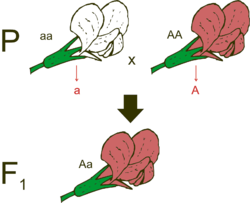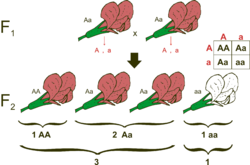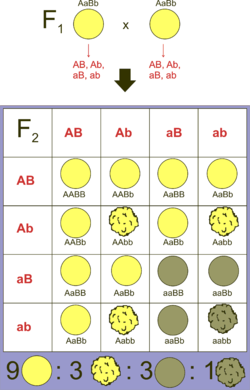Basic laws of genetics
Mendel's Laws
For each diploid offspring, the allelic pair consists of one allele paternal and one maternal allele. The transmission of alleles to offspring is subject to the basic rules of combinatorics. It was J. G. Mendel that first solved this problem. It was also from him that combinatorial (Mendelian) squares originated. His findings can be summarized in the 3 Mendel Laws. Mendel's laws are universal, forming the basis of genetic science. They are the result of his experiments with pea varieties - he crossed pure lines of varieties that differed in one or more well-defined traits and observed at least two generations of offspring of the crosses.
1st law - uniformity
Law of uniformity of F1 generation (1st filial = first generation of offspring). When 2 homozygotes are crossed, the offspring genotypes and phenotypes are uniform. When 2 different homozygotes are involved, the offspring are always heterozygous hybrids.
2nd law - segregation
Law of random segregation of genes into gametes (Law of fission ratios in the F2 generation). When 2 heterozygotes are crossed, each of the 2 alleles (dominant and recessive) can be passed on to the offspring with equal probability. Thus, genotypic and hence phenotypic splitting = segregation occurs. The probability for the offspring is therefore 25% (homozygous dominant individual) : 50% (heterozygote) : 25% (homozygous recessive individual). Thus, genotypic cleavage ratio is 1:2:1. Phenotypic cleavage ratio is 3:1. If there is an codominance relationship between alleles, the phenotypic cleavage ratio corresponds to the genotypic cleavage ratio (i.e. 1:2:1).
3rd law - independent choice
Law of independent combinability of alleles. When 2 alleles are examined simultaneously, the same regular segregation occurs. If we have 2 polyhybrids AaBb each can form 4 different gametes (AB, Ab, aB, ab). Thus, when these 2 gametes cross each other, 16 different zygotic combinations are produced. However, some combinations are repeated, so that only 9 different genotypes are eventually produced (ratio 1:2:1:2:4:2:1:2:1). We are offered only 4 possible phenotypic expressions (dominant in both characters, dominant in 1 and recessive in 2, recessive in 1 and dominant in 2, recessive in both). The phenotypic cleavage ratio is 9:3:3:1. Of course, this law only holds if the genes under study are located on different chromosomes.
Morgan's Laws
T. H. Morgan summarized the basic knowledge about custody into three laws:
- Genes are always stored on chromosome linearly.
- The genes of one chromosome form a linkage group. The number of binding groups of an organism is the same as the number of pairs of homologous chromosomes of the respective organism.
- Gene exchange can take place between the genes of a homologous pair of chromosomes through crossing-over. The frequency of crossing-over is proportional to the distance of the genes.
These laws form the so-called chromosome theory of heredity.
Links
Related Articles
Source
- OTOVÁ, Berta, et al. Lékařská biologie a genetika I. díl. 1. edition. Karolinum, 2015. 123 pp. ISBN 978-80-246-1594-3.
- ŠTEFÁNEK, Jiří. Medicína, nemoci, studium na 1. LF UK [online]. [cit. 2010-02-11]. <https://www.stefajir.cz/>.



